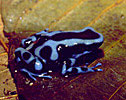


Alkaloids are secreted from glands located on the frog’s skin, but it is only released when the frog is scared. South American Natives rub the toxins of the poison dart frog on the tips of their blowgun darts. It is a useful weapon that will quickly kill dinner. Poison is extracted when the hunters heat a living frog over the campfire, and the toxins drip off of the body into a small pan.
Poison dart frogs are social
creatures, and mainly live on the forest floor. These frogs are able to climb trees, and
have sticky pads on the underside of every toe to help them cling to wet leaves and
branches.

Eggs are lain close to the ground, and when hatched the female poison dart frog will carry the tadpoles on her back to a rain-filled bromeliad. There they will complete the transformation to adulthood. The mother will return occasionally to check on her tadpoles and assure they are safe.
Color begins to appear on the tadpoles’ skin, and with it poison. Soon after, the metamorphosis is complete, and a new frog leaves the bromeliad to begin its adult life.